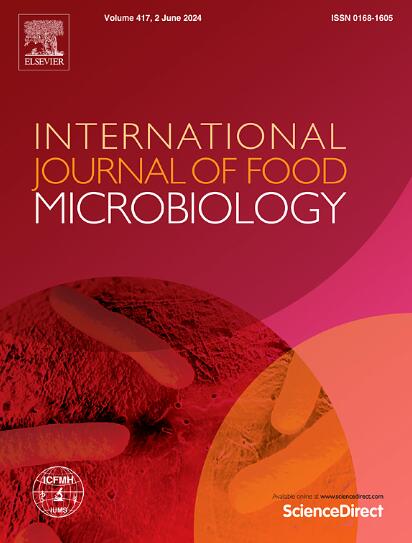Mechanisms of antifungal activity of ehimensin F6 produced by Paenibacillus ehimensis HD against Penicillium expansum
IF 5
1区 农林科学
Q1 FOOD SCIENCE & TECHNOLOGY
International journal of food microbiology
Pub Date : 2025-03-28
DOI:10.1016/j.ijfoodmicro.2025.111184
引用次数: 0
Abstract
Penicillium expansum is a common spoilage fungus in postharvest fruits that can lead to fruit rot and health damage. This study aims to identify the antimicrobial mechanism of antimicrobial peptide named ehimensin F6 from Paenibacillus ehimensis HD against P. expansum. The ehimensin F6 was applied to the fresh mycelia of P. expansum at varying concentrations of 0MIC, 0.5MIC, 1MIC, and 2MIC (final concentration) to evaluate its effects on the cell wall, cell membrane, genomic DNA, and proteins of P. expansum mycelia. In addition, cherries were divided into four groups: treated with sterile water, low/high concentrations of ehimensin F6, or potassium sorbate. All were inoculated with P. expansum, stored at 25 °C for 5 days, and evaluated for antifungal effects by measuring lesion diameters and viable counts of P. expansum. The results demonstrated that ehimensin F6 obviously inhibited the growth of P. expansum in a dose-dependent manner. Fluorescence spectroscopy analysis indicated that ehimensin F6 destroyed the integrity of the fungal cell membrane and increased cell membrane permeability, leading to membrane potential dissipation and K+ leakage. Electron microscopy observations revealed obvious significant morphological alterations in P. expansum mycelia, including structural damage, deformation of hyphae, and a reduction in cytoplasmic density. Transcriptomics and proteomics analyses showed that ehimensin F6 affected ergosterol biosynthesis pathway, DNA replication, rnhA and RPB1 genes expression in RNA transcription, amino acid and pyruvate metabolism. Ehimensin F6 effectively inhibited the growth of P. expansum in cherries. These results indicated that ehimensin F6 inhibited the growth and metabolism of P. expansum through many different pathways, and ehimensin F6 had great potential as a bio-preservative to improve food safety.
ehimenbacillus ehimensis HD产的ehimenin F6对扩张青霉的抑菌作用机制
膨胀青霉是一种常见的水果采后腐败真菌,可导致水果腐烂和健康损害。本研究旨在探讨从eenibacillus ehimensis HD提取的抗菌肽ehimenin F6对大肠杆菌的抑菌作用机制。以0MIC、0.5MIC、1MIC、2MIC(终浓度)不同浓度的ehimenin F6分别作用于新鲜的舒展菌菌丝,评价其对舒展菌菌丝细胞壁、细胞膜、基因组DNA和蛋白质的影响。此外,樱桃被分成四组:用无菌水、低/高浓度的ehimenin F6或山梨酸钾处理。所有实验均接种舒展芽孢菌,在25℃下保存5 d,通过测定舒展芽孢菌的病变直径和活菌数来评价其抗真菌效果。结果表明,ehimenin F6对大芽孢杆菌的生长有明显的抑制作用,且呈剂量依赖性。荧光光谱分析表明,ehimenin F6破坏了真菌细胞膜的完整性,增加了细胞膜的通透性,导致膜电位耗散和K+泄漏。电镜观察结果显示,白沙芽菌丝形态发生了明显的变化,包括结构损伤、菌丝变形和细胞质密度降低。转录组学和蛋白质组学分析表明,ehimen蛋白F6影响麦角甾醇生物合成途径、DNA复制、RNA转录、氨基酸和丙酮酸代谢中的rnhA和RPB1基因表达。Ehimensin F6能有效抑制杏叶枯斑菌的生长。这些结果表明,ehimenin F6通过多种途径抑制膨化芽孢杆菌的生长和代谢,具有作为生物防腐剂提高食品安全性的潜力。
本文章由计算机程序翻译,如有差异,请以英文原文为准。
求助全文
约1分钟内获得全文
求助全文
来源期刊
CiteScore
10.40
自引率
5.60%
发文量
322
审稿时长
65 days
期刊介绍:
The International Journal of Food Microbiology publishes papers dealing with all aspects of food microbiology. Articles must present information that is novel, has high impact and interest, and is of high scientific quality. They should provide scientific or technological advancement in the specific field of interest of the journal and enhance its strong international reputation. Preliminary or confirmatory results as well as contributions not strictly related to food microbiology will not be considered for publication.

 求助内容:
求助内容: 应助结果提醒方式:
应助结果提醒方式:


